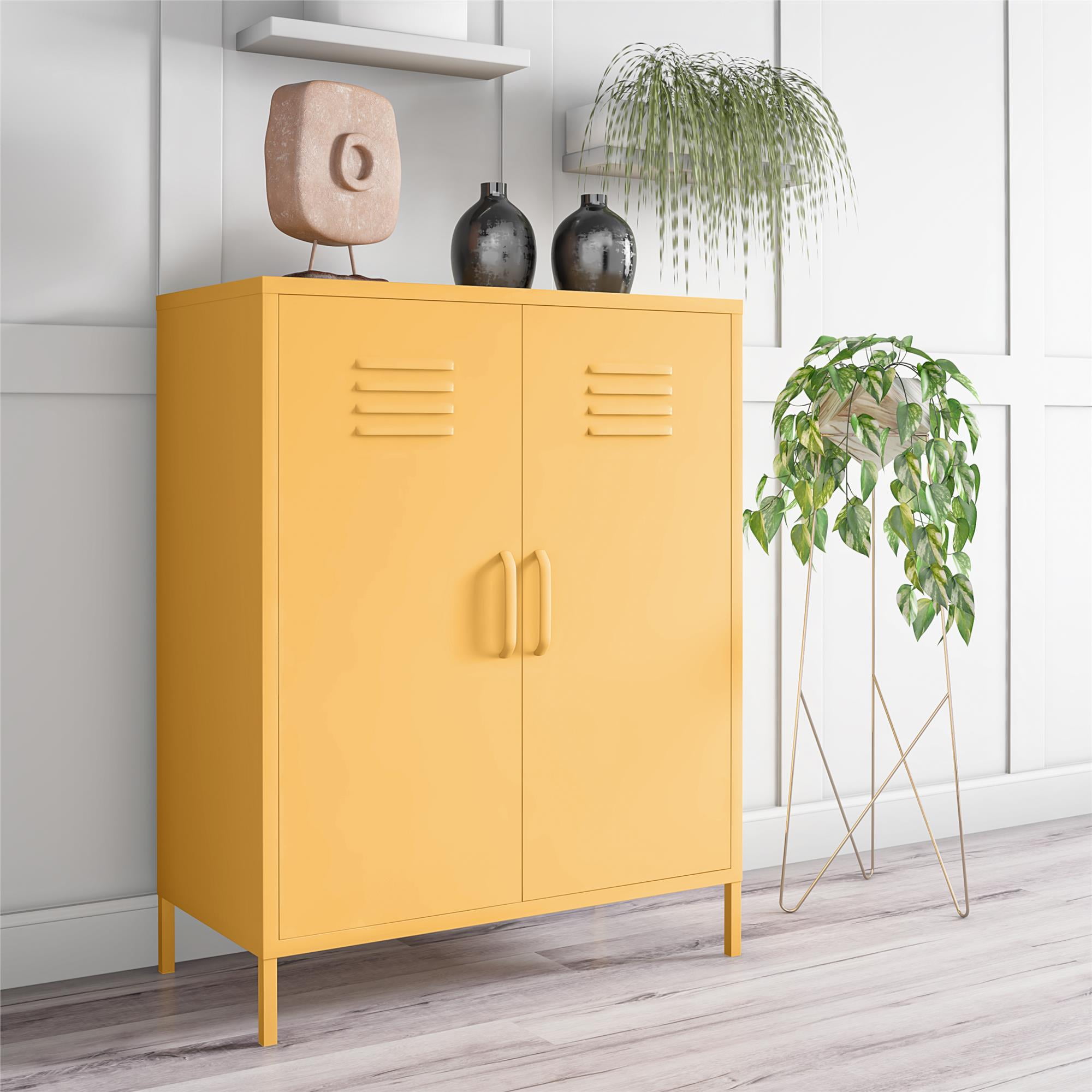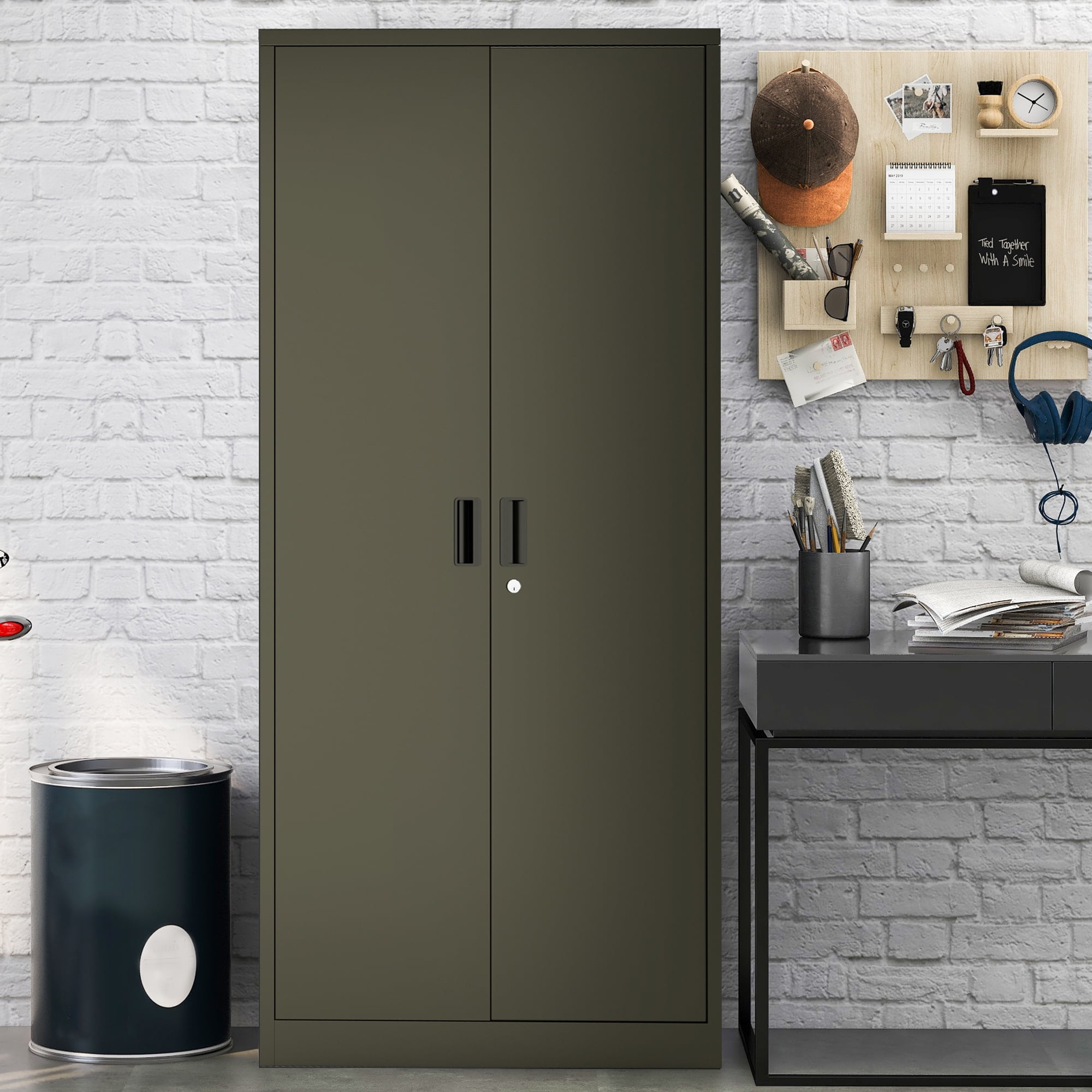Types of Cabinets with Metal Doors
Metal cabinets offer durability and a sleek aesthetic, making them a popular choice for various settings, from industrial workshops to modern kitchens. The choice of cabinet type depends heavily on the intended use and the desired level of protection and visual appeal. Understanding the different styles, materials, and design features is crucial for making an informed decision.
Cabinet Styles, Materials, and Applications
The following table summarizes various styles of metal cabinets, their typical materials, common applications, and associated advantages and disadvantages.
| Style | Material | Typical Use | Pros/Cons |
|---|---|---|---|
| Single Door | Steel, Aluminum, Stainless Steel | Small storage, tool storage, office supplies | Pros: Simple, inexpensive. Cons: Limited storage capacity. |
| Double Door | Steel, Stainless Steel | Larger storage, equipment storage, workshops | Pros: Increased storage capacity. Cons: Can be heavy and difficult to move. |
| Multi-Door | Steel, Aluminum | Large-scale storage, industrial settings, archives | Pros: High storage capacity, modular design options. Cons: High cost, complex installation. |
| Wall-Mounted | Aluminum, Stainless Steel | Small item storage, kitchens, bathrooms | Pros: Space-saving, easy access. Cons: Limited storage capacity, weight restrictions. |
| Free-Standing | Steel, Stainless Steel | General purpose storage, garages, workshops | Pros: Versatile, robust. Cons: Requires floor space. |
Metal Types for Cabinet Doors: A Comparison
The choice of metal significantly impacts the cabinet’s durability, aesthetics, and cost. Here’s a breakdown of common metal types:
Cabinet with metal doors – The selection of metal for cabinet doors significantly influences the overall performance and longevity of the unit. Each metal possesses unique properties that make it suitable for specific applications.
- Steel:
- High strength and durability.
- Relatively inexpensive.
- Susceptible to rust and corrosion unless properly treated (e.g., powder coating, galvanization).
- Available in various finishes (e.g., painted, powder-coated).
- Aluminum:
- Lightweight and corrosion-resistant.
- Higher cost than steel.
- Excellent for outdoor applications.
- Can be easily anodized for enhanced aesthetics and durability.
- Stainless Steel:
- Highly corrosion-resistant and durable.
- High cost compared to steel and aluminum.
- Excellent for food processing and hygiene-sensitive environments.
- Available in various grades with different properties.
Design Features of Metal Cabinet Doors
Handles, hinges, and locking mechanisms are critical design elements that affect both functionality and aesthetics.
The selection of appropriate handles, hinges, and locking mechanisms is crucial for ensuring the cabinet’s ease of use, security, and overall lifespan. These elements contribute significantly to the cabinet’s overall aesthetics and functionality.
| Handle Style | Suitability |
|---|---|
| Recessed Handles | Sleek, modern cabinets; minimizes damage risk. |
| Flush Pull Handles | Modern, minimalist designs; easy grip. |
| Cup Handles | Traditional cabinets; comfortable grip. |
| Bar Handles | Industrial or contemporary styles; robust and durable. |
Applications and Uses of Cabinets with Metal Doors

Metal cabinets with metal doors offer unparalleled durability and security, making them indispensable in a wide range of settings. Their robust construction and resistance to damage ensure the protection of valuable contents, while their aesthetic appeal can complement diverse environments. From commercial kitchens to industrial facilities and even home garages, these cabinets provide a versatile storage solution that prioritizes both functionality and longevity.
The inherent strength and security features of metal door cabinets translate into numerous practical applications across diverse sectors. Their resistance to fire, moisture, and impact makes them ideal for storing sensitive equipment or valuable materials. The choice of material, door type, and security features can be tailored to specific needs, ensuring optimal protection and organization.
Commercial Kitchen Applications
In commercial kitchens, where hygiene and durability are paramount, metal cabinets with metal doors are essential for maintaining a clean and organized workspace. The smooth, easily cleanable surfaces prevent the buildup of bacteria and grease, while the robust construction withstands the rigors of daily use.
- Storing food supplies and ingredients.
- Housing cleaning supplies and equipment.
- Protecting valuable kitchenware and equipment.
- Containing waste disposal and recycling.
Industrial Environment Applications
Industrial settings demand robust storage solutions capable of withstanding harsh conditions and protecting valuable equipment and materials. Metal cabinets with metal doors excel in these environments, providing secure and durable storage for a variety of items.
- Storing sensitive electronic components.
- Securing hazardous materials and chemicals.
- Protecting valuable tools and equipment from theft and damage.
- Organizing inventory and supplies in a structured manner.
Home Garage Applications
Even in residential settings, metal cabinets with metal doors offer practical advantages. Their durability and security make them ideal for organizing tools, equipment, and valuable items in a garage environment.
- Storing tools and equipment safely and securely.
- Protecting sensitive items from theft and damage.
- Organizing seasonal items and sporting equipment.
- Creating a more organized and efficient garage space.
Enhanced Security and Durability Examples
The benefits of metal door cabinets extend beyond simple storage. Their inherent strength and security features offer significant advantages in various contexts. For instance, in a laboratory setting, these cabinets protect sensitive chemicals and equipment from unauthorized access and accidental damage. Similarly, in a retail environment, they safeguard valuable inventory from theft.
High-Security Server Room Scenario
Imagine a high-security server room requiring robust protection for sensitive data and expensive equipment. A custom-designed cabinet with 14-gauge steel construction, reinforced hinges, and a three-point locking mechanism would provide exceptional security. The doors could be fitted with a biometric lock for advanced access control, and the cabinet itself could be anchored to the floor to prevent theft. This choice of materials and security features ensures the utmost protection for critical IT infrastructure, minimizing the risk of data breaches and equipment damage. The cabinet’s interior could be further customized with adjustable shelving and cable management systems to optimize space and organization.
Maintenance and Care of Cabinets with Metal Doors: Cabinet With Metal Doors

Maintaining metal cabinet doors ensures their longevity and preserves their aesthetic appeal. Regular cleaning and addressing potential issues promptly will prevent significant damage and extend the lifespan of your cabinets. Different metals require slightly different care, so understanding your cabinet’s material is crucial.
Cleaning and Maintenance Procedures for Metal Cabinet Doors, Cabinet with metal doors
Proper cleaning techniques vary depending on the type of metal. Stainless steel, for example, requires a different approach than aluminum or painted steel. Following a consistent cleaning schedule will prevent grime buildup and maintain a professional look.
- Preparation: Always begin by clearing the area around the cabinets. Remove any items stored on top or near the doors to prevent accidental damage or spills.
- Dusting: Use a soft, dry cloth or microfiber duster to remove loose dust and debris. This prevents scratching during the subsequent cleaning steps.
- Cleaning: For stainless steel, use a mild detergent and warm water solution. Apply the solution with a soft cloth, wiping in the direction of the grain to avoid streaks. Rinse with clean water and dry thoroughly with a clean, soft cloth. For aluminum, a similar approach can be used, but avoid abrasive cleaners. Painted steel cabinets should be cleaned with a gentle cleaner specifically designed for painted surfaces, avoiding harsh chemicals.
- Drying: Thoroughly dry the cabinet doors to prevent water spots or corrosion. Use a clean, soft cloth to ensure a streak-free finish.
- Regular Maintenance: Dust and wipe down the cabinets weekly or as needed. For more intensive cleaning, perform a deeper clean monthly or quarterly, depending on the level of use and environmental factors.
Recommended cleaning products include mild dish soap, specialized stainless steel cleaners (for stainless steel cabinets), and cleaners specifically formulated for painted metal surfaces. Avoid abrasive cleaners, scouring pads, and harsh chemicals, as these can damage the finish.
Common Issues and Solutions for Metal Cabinet Doors
Several issues can arise with metal cabinet doors over time. Knowing how to address these problems promptly can save you significant repair costs or even replacement.
- Rust: Rust is a common problem for steel cabinets, especially in humid environments. To prevent rust, ensure proper ventilation and avoid prolonged exposure to moisture. If rust appears, use a rust remover specifically designed for metal surfaces, following the product’s instructions carefully. After removing the rust, apply a protective coating to prevent future rust formation.
- Dents: Dents can be caused by impacts. For minor dents, you might be able to gently push them out from the back using a suction cup or a specialized dent removal tool. For more significant dents, professional repair may be necessary.
- Scratches: Scratches are common on metal surfaces. For minor scratches, you can try using a metal polish to buff them out. For deeper scratches, touch-up paint (for painted steel) or a specialized metal repair kit may be necessary.
- Loose Hinges or Handles: Over time, hinges or handles may loosen. Tighten loose screws or replace damaged hardware as needed.
